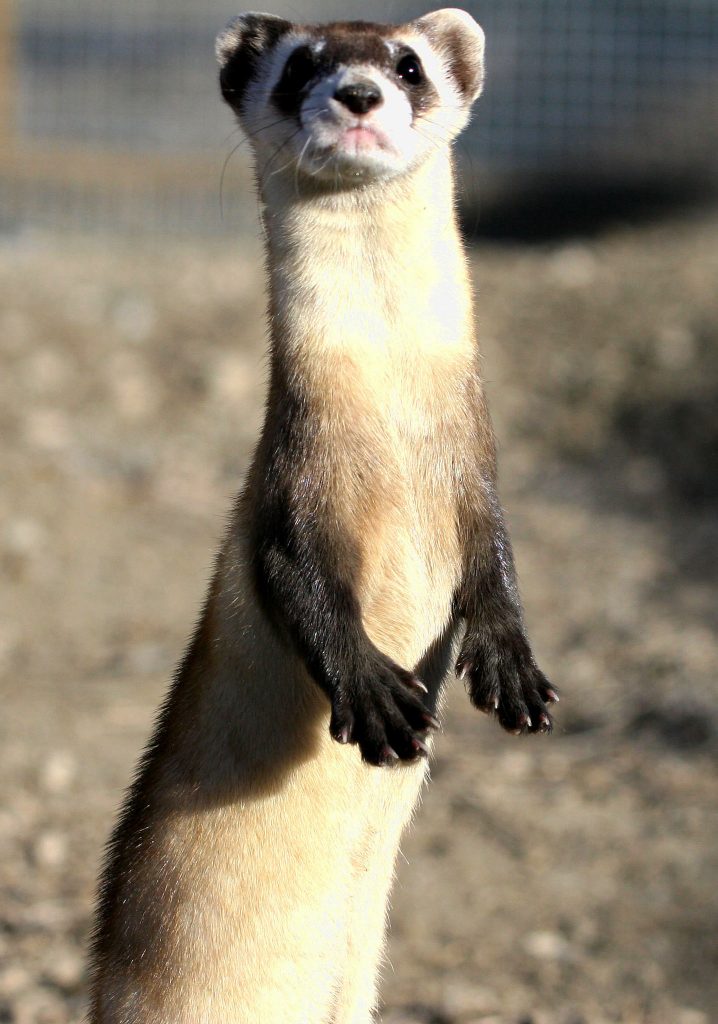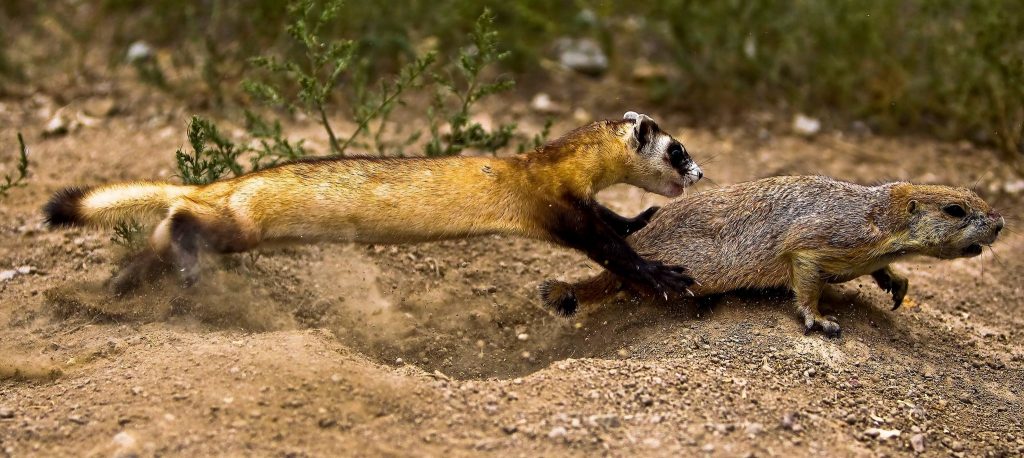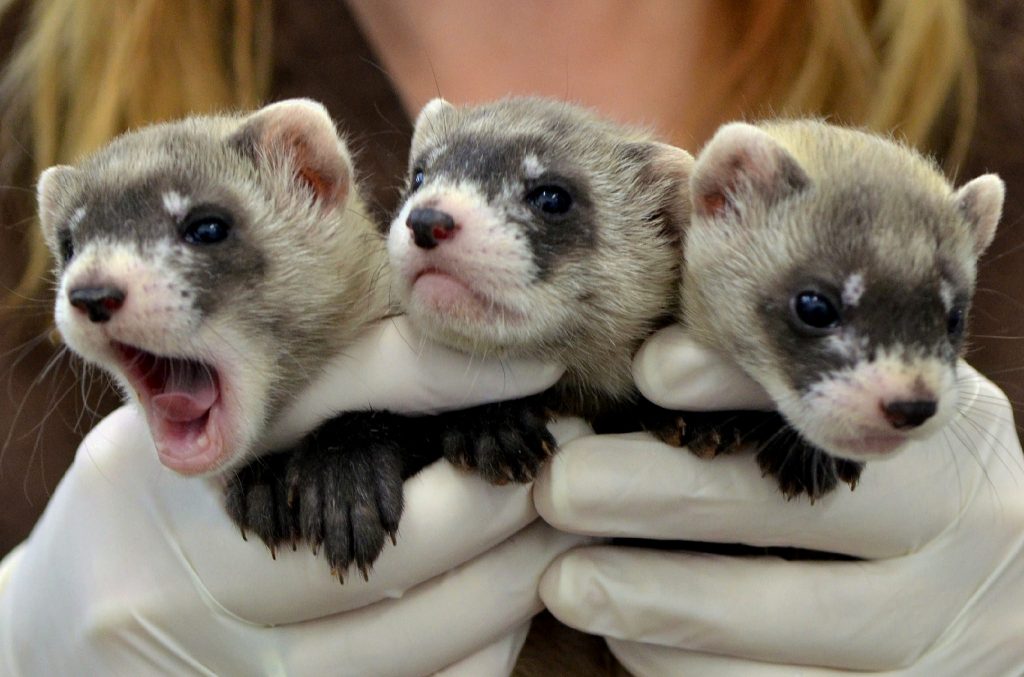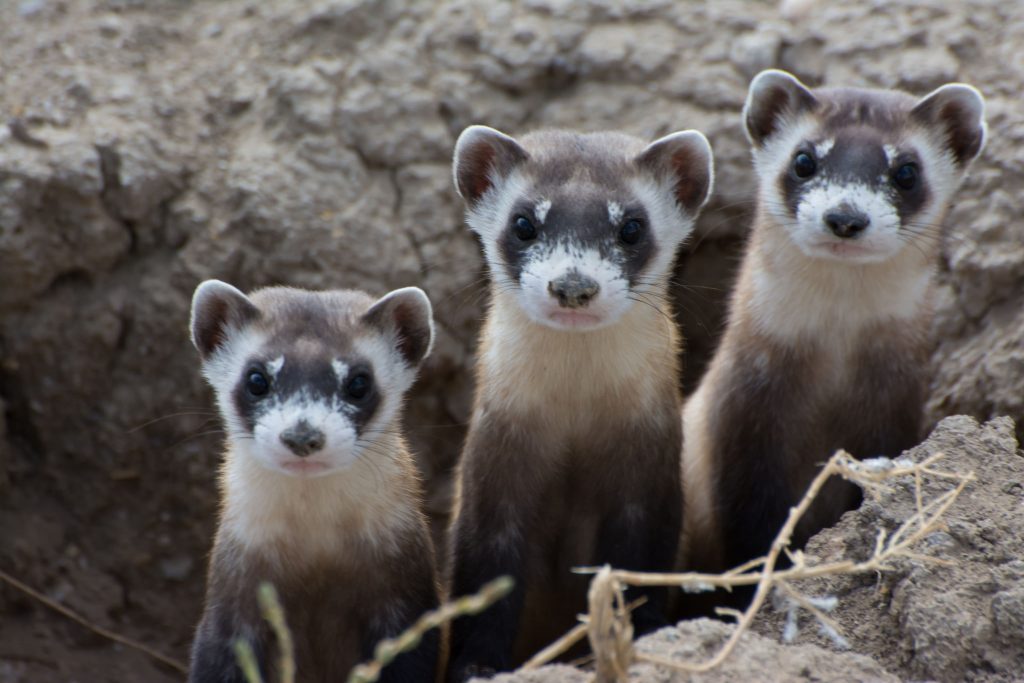How The West Will Be Won (For The Black-Footed Ferret)
16:22 minutes

With its silky fur and bandit-masked face, the black-footed ferret cuts a cute — if lethal — figure on the American plains. It’s also the star of a great comeback story: The species was thought extinct until 1981, when a small group of ferrets was discovered on a Wyoming ranch.
Today, there are more than 500 black-footed ferrets in captivity and the wild, thanks to ongoing breeding and reintroduction efforts. But hard times aren’t over for the little predator: It mainly hunts prairie dogs, which are widely considered to be agricultural pests. What’s more, both ferrets and prairie dogs are dying from an invasive plague that’s slashed ferret numbers from 1,500 just a few years ago. So, can the black-footed ferret prosper again?
John Hughes, a wildlife biologist with the US Fish and Wildlife Service’s black-footed ferret recovery program, is hopeful — relatively speaking. “Ferrets have always been a rare species,” he notes. Their “Achilles’ heel,” he says, is their dependence on prairie dogs for food and shelter. (Black-footed ferrets live in empty prairie dog burrows.)
[Learn about the remarkable comeback of the New Zealand sea lion pup.]

“And while prairie dogs are much more adaptable to changing conditions, ferrets, due to their territoriality, are not,” he says. “As habitat was lost and prairie dog control occurred, ferrets declined along with it.”
There’s also the sylvatic plague to consider. Thought to have been introduced by shipborne rats in San Francisco more than a century ago, Hughes says the invasive bacteria have been marching eastward ever since — straight across the black-footed ferret’s native territory. His team has been using insecticides to kill fleas — the plague’s primary vector — inside prairie dog burrows.
“That has been somewhat successful,” Hughes says. “It has allowed us to hang on to ferret populations at several of our landmark sites.” But the insecticide has major downsides: “It is labor-intensive and expensive,” he adds. “And … you know, it’s never a good idea to be putting out a broad-spectrum insecticide year after year.”

An oral plague vaccine for prairie dogs is also in the works, and Hughes says the early results are promising. “If the rodents consume a bait, then they’re immunized for their entire life against plague. So we see this as a very important management tool to keep ferrets and prairie dogs on the landscape where they’re tolerated.”
But to thrive, the black-footed ferret will need more than plague control — it needs land and food. As Hughes explains, the ferret’s most important prey, black-tailed prairie dogs, are native to the Great Plains. “And most of the Great Plains is privately owned,” he says.
The goals for the ferret recovery program, which Hughes calls “relatively modest,” are to get 3,000 wild ferrets living in nine of the 12 states where they were originally found, with 10 populations numbering at least 100 ferrets strong. “And we feel that we can do that on a total of 500,000 acres across the 12 states if those acres are purposely managed for plague,” he says.
That’s where landowners like the Haverfields come in. In 2007, Kansas ranchers Larry and Bette Haverfield welcomed 14 black-footed ferret kits onto their land — a reintroduction that meant fostering a healthy prairie dog population there as well, much to the ire of their neighbors and the county.
“I think [my father] just had a strong belief, as a rancher, that prairie dogs were part of the ecosystem and a keystone species on top of that, which meant that a lot of native animals and birds relied on the prairie dog for food and shelter,” says Cathy Lucas of her father, Larry Haverfield, who died in 2014.
“He did rotation grazing and was a big believer in that, and he believed prairie dogs helped with that and made the grass more nutritious, aerated the soil, and rain would percolate in the burrows of the prairie dogs, all things that he thought contributed to successful ranching.”
For the black-footed ferret to thrive, Hughes hopes more landowners in the Great Plains will think along the same lines as the Haverfields.
“I think a lot of folks in rural areas look at … a national program like the black-footed ferret recovery program and assume that it’s universal in application and ‘they’re going to make me have prairie dogs’ or ‘they’re going to make me change my operation,’” he says.
“Really, it is voluntary and incentive-based, and we don’t need every person out there to support prairie dogs and ferrets, but we just need enough to support that recovery goal. So it’s, again, very voluntary, and we’re very grateful for landowners like the Haverfields that are willing to support ferret recovery.”

Cathy Lucas is a spokesperson for the Larry and Bette Haverfield family in Sublette, Kansas.
John Hughes is a wildlife biologist with the U.S. Fish and Wildlife Service Black-Footed Ferret Recovery Program in Carr, Colorado.
IRA FLATOW: This is Science Friday. I’m Ira Flatow. Poke your head into a prairie dog den and you might be surprised to see something that is not a prairie dog. Perhaps a burrowing owl, a snake, a cute little face with a black mask, maybe with a dead prairie dog dangling out of its jaws. That’s the black-footed ferret, and not too long ago, they were nearly extinct. In fact, in 1981, there were just 18 of them. Fast-forward a couple of decades, and there are more than 500 ferrets in captivity and the wild. And that is thanks to careful captive breeding and reintroduction efforts.
But it wasn’t an easy process, and there are lots of challenges remaining for this plucky predator. Take the fact that they rely entirely on prairie dogs for food, and people who depend on the land for a living, they don’t have much fondness for prairie dogs. There’s also this little plague related to the Black Death that’s killing off prairie dogs and ferrets alike. There were actually as many as 1,500 ferrets just a few years ago until the plague. So what’s a biologist to do? Can the black-footed ferret make it back to prosperity? I have a couple of guests here to tackle that question.
John Hughes is a wildlife biologist with the US Fish and Wildlife Service’s black-footed ferret recovery program. Welcome to Science Friday, John.
JOHN HUGHES: Thank you for having me.
IRA FLATOW: You’re welcome. Cathy Lucas, daughter and spokesperson for one ranching family that has helped bring black-footed ferrets back to their slice of Western Kansas. Welcome to Science Friday.
CATHY LUCAS: Thank you. I’m pleased to be here.
IRA FLATOW: Well, we’re happy to have you. John, I just said there were 18 ferrets left in 1981, but that really is not the whole story, is it? How were those ferrets ever found?
JOHN HUGHES: It’s a really compelling conservation story, at least in my humble opinion. Ferrets have always been a rare species. They were relatively late described to science, primarily due to their nocturnal habits. And the most studied population prior to 1981 came from South Central South Dakota. And in fact, an earlier effort at captive breeding took place with those animals, and unfortunately, the last animal died in captivity in 1979. And it was thought, at that time, that the species was extinct. And the rediscovery of ferrets in 1981 was a complete accident, if you will.
There’s a ranching family near Meeteetse, Wyoming, John and Lucille Hogg, having breakfast on their back porch one morning, and their dog, appropriately named Shep, drug a carcass up. And it was kind of a strange-looking animal, and John Hogg didn’t think much of it, threw it on his trash pile. His wife, Lucille, retrieved it and took it to a local taxidermist, who knew the story of black-footed ferrets, contacted the Wyoming Game and Fish Department, and that’s what kicked off the rediscovery of the black-footed ferret, attributable to a dog named Shep.
IRA FLATOW: Wow, that is a great story. Anybody who looks at a picture of the ferret, the black-footed one, it’s such a cute little creature. How did we let them get into such a bad spot in the first place?
JOHN HUGHES: The ferret’s Achilles heel, I guess, is its extreme specialization. The ferret’s predecessor– well, its closest living relative– is the Siberian polecat of Eastern Asian Steppes. And it’s thought that the ferret’s predecessor crossed the Bering land bridge into North America and encountered prairie dogs, which is kind of a hyperabundant prey species. And upon encountering them, they became an extreme specialist and really wholly dependent on prairie dogs, both for food and shelter. And since prairie dogs have been long regarded as an agricultural pest, as prairie dogs went, so did ferrets.
And while prairie dogs are much more adaptable to changing conditions, ferrets, due to their territoriality, are not. And as habitat was lost and prairie dog control occurred, ferrets declined along with it.
IRA FLATOW: Cathy, your father, Larry Haverfield, introduced the first and so far the only wild population of black-footed ferrets back to Kansas on your family ranch, and this turned into a bit of a war, didn’t it?
CATHY LUCAS: Yes. They call it the Prairie Dog Wars. It lasted for about six years.
IRA FLATOW: And tell us about that. Why was your father motivated, if it was this difficult?
CATHY LUCAS: Well, I think he just had a strong belief, as a rancher, that prairie dogs were part of the ecosystem and a keystone species on top of that, which meant that a lot of native animals and birds relied on the prairie dog for food and shelter. And he did rotation grazing and was a big believer in that, and he believed prairie dogs helped with that and made the grass more nutritious, aerated the soil, and rain would percolate in the burrows of the prairie dogs, all things that he thought contributed to successful ranching.
IRA FLATOW: You talked about the wars. Give us an idea of the intensity of the wars. What happened?
CATHY LUCAS: Well, I can tell you how it got started. The county sent letters to Dad and other landowners saying get rid of the– we’re going to come on your property and get rid of the prairie dogs and bill you, and if you don’t pay the bill, then we’ll put it as a lien on your property taxes. So Dad was reading his letter and Gordon Barnhardt, one of the neighboring landowners, had received a similar letter and called Dad. And Gordon asked Dad if he wanted to fight it, and Dad said, yes, but I don’t know where to start. And Gordon said he knew of a Wichita attorney that might be able to help, and that was Wichita environmental law attorney Randy Rathbun.
This happened back in 2005. So they met up with Randy, and he said he’d do what he could. But in the meantime, the county commissioners had a meeting open to the public about what they called the prairie dog issue. And Dad went and, in time, he stood up and said he liked prairie dogs. Well, that was not a popular thing to say, and in the local newspaper, the big headline was 99 to 1 with Dad being the only one for the prairie dogs. Plus, it went even further than that. The New York Times had a article which had a headline of “In Kansas, a Line is Drawn Around a Prairie Dog Town.”
So the ride began, and Dad said, in his mind, it was like being on old 1950s bus with curved lines. And attorney Randy was the driver. Dad and Mom and the neighboring landowners, Gordon and Martha Barnhardt and Maxine Blank, were the passengers. And then Audubon of Kansas supported these ranchers. Plus, their executive director, Ron, was kind of like a conductor on the bus.
So in November of 2005, a letter was sent to US Fish and Wildlife Service about the possibility of reintroduction of black-footed ferrets on the ranch. And Dad said in his imaginary bus that he thought of, here now the Kansas Wildlife Federation had joined us, and Randy, as driver, would say, here we go. Which is what Randy would always say as they went into numerous court hearings. And sometimes the road was smooth, and sometimes it was bumpy. But the Defenders of Wildlife came on board when the US Fish and Wildlife Service opened up for public opinion about the reintroduction project in Kansas, and 16,000 defenders sent positive messages. And in time, the US Fish and Wildlife Service released 14 endangered black-footed ferret kits in 2007.
IRA FLATOW: And John, the ferret’s struggle ended up more complicated in just what did [INAUDIBLE]. I mentioned that there was a plague, too, that was devastating.
JOHN HUGHES: Yes, and as Cathy mentioned, public attitudes are a significant challenge, too. Ferret recovery, we’re making good progress in cooperation with our partners in that regard, but plague kind of really knocked us for a loop. And this is the same plague that wiped out the population in Eastern Europe or in Europe in the Middle Ages. And like Asian carp or cheatgrass or zebra mussels, it’s an invasive species to North America. And as such, native species like black-footed ferrets and prairie dogs do not have immunity to it.
And plague has slowly marched its way eastward. It was thought to have been introduced via shipborne rats in San Francisco around 1900, and it’s really ubiquitous throughout the black-footed ferret’s range now and directly lethal to ferrets and prairie dogs both.
IRA FLATOW: Is there anything, any medication? I understand that there’s a vaccine in development now?
JOHN HUGHES: Yes, there’s a number of tools that we utilize. One has been utilized for quite some time, and it’s an application of an insecticide, deltamethrin, to prairie dog burrows to kill fleas, and fleas being the primary vector or transmitter of plague. An infected flea bites a prairie dog or a ferret and infects it with plague, and then it dies and spreads throughout the system. That has been somewhat successful. It has allowed us to hang on to ferret populations at several of our kind of landmark sites. It is labor intensive and expensive, and unfortunate– you know, it’s never a good idea to be putting out a broad-spectrum insecticide year after year.
And through some recent developments, spearheaded by the US Geological Survey’s National Wildlife Health Center and several other partners, such as Colorado Parks and Wildlife, have developed an oral vaccine administered to prairie dogs to treat what’s called sylvatic plagues. Sylvatic refers to plague in a wildlife population. Initial results are quite promising. If the rodents consume a bait, then they’re immunized for their entire life against plague. So we see this as a very important management tool to keep ferrets and prairie dogs on the landscape where they’re tolerated.
IRA FLATOW: So when do you think and what’s it going to take to get the black-footed ferret off the endangered list at this point?
JOHN HUGHES: Our recovery goals as a program are relatively modest. We need 3,000 animals in the wild in 9 of the 12 states where it originally occurred, with 10 populations numbering more than 100 individuals each. And we feel that we can do that on a total of 500,000 acres across the 12 states if those acres are purposely managed for plague. And this takes a lot of cooperation between partners such as state agencies, non-governmental organizations, and, of course, landowners like the Haverfields.
IRA FLATOW: Why can’t we just use the public lands for restoring the black-footed ferret?
JOHN HUGHES: Well, there simply aren’t enough of them. Historically, ferrets occurred in association with three prairie dog species– black-tailed prairie dogs, white-tailed prairie dogs, and Gunnison’s prairie dogs. Black-tailed being, by far, the most important. About 80% of ferrets occurred with black tails. Black-tailed prairie dogs are the ones that you see flying into Denver International Airport and across the Great Plains, and most of the Great Plains is privately owned. And if we’re going to recover the ferret, we’re going to need partners like the Haverfields to get it done. And it’s up to us to develop innovative tools to do that.
IRA FLATOW: I’m Ira Flatow. This is Science Friday from PRI, Public Radio International, talking about the recovery of the black-footed ferret with John Hughes and Cathy Lucas. John, how do you argue for the value of prairie dogs and ferrets to ranchers who are worried about the value of their cattle or their crop? What’s the argument you use there?
JOHN HUGHES: That’s a tough one. For many, many years, prairie dogs have been widely regarded as an agricultural pest. In fact, federal and state agencies initiated very large-scale prairie dog control programs around the turn of the century. Those have been largely discontinued. As Cathy mentioned, her dad was very innovative in that he found ways to work with prairie dogs rather than against them.
That being said, you know, the private landowner community is much more diverse than a lot of folks give it credit for being. The next neighbor over may say, no way, no how, no prairie dogs can ever exist here. The next neighbor over may say, well, I’d be willing to support prairie dogs if it was incentivized. Or there may be folks like the Haverfields that have figured out how to work with them. And our challenge is finding enough folks to support prairie dogs and accommodate that relatively modest recovery goal.
IRA FLATOW: Cathy Lucas, you have the ferrets on your property. Have you ever seen one running around?
CATHY LUCAS: Yes, and it is a memorable event, because it happened in the dark, and their emerald eyes are just so noticeable. And it moved so quickly that I thought it was two, but my dad said, no, because they move so quick, you saw the same ferret, but his eyes in two different places.
IRA FLATOW: Does your dad feel vindicated now that he fought so hard for them?
CATHY LUCAS: Well, my father passed away in 2014, but the family is carrying on his legacy. And I believe that he was proud of the fact that under Kansas law, a precedent was set, after this six-year battle, legal battle, meaning the Endangered Species Act preempts the 1901 Kansas statute which required eradication.
IRA FLATOW: And John, I guess this is a story that you don’t have to have so much government interference and that people can learn how to do things cooperatively.
JOHN HUGHES: Absolutely, and I think a lot of folks in rural areas look at something like a national program like the black-footed ferret recovery program and assume that it’s universal in application and they’re going to make me have prairie dogs or they’re make me change my operation. Really, it is voluntary and incentive based. And we don’t need every person out there to support prairie dogs and ferrets, but we just need enough to support that recovery goal. So it’s, again, very voluntary, and we’re very grateful for landowners like the Haverfields that are willing to support ferret recovery.
IRA FLATOW: And just to be sure, as we wrap up here, these are not the cute, furry things, the regular ferrets you might see in the pet store. These are wild animals, right?
JOHN HUGHES: Yes, very much so.
IRA FLATOW: And you’re not going to take them home and make pets out of these.
JOHN HUGHES: No, that would be pretty impossible. They’re a vicious predator. They’re designed to be killing machines, and they do that very well. And while they are related to domestic ferrets, they’re a force of nature, a pretty remarkable animal.
IRA FLATOW: Well, you guys tell a remarkable story. Let me thank both of you. John Hughes, wildlife biologist with US Fish and Wildlife Service, and Cathy Lucas, daughter of Larry Haverfield, and she’s a spokesperson for the Haverfield family. Thank you both for taking time to be with us today.
JOHN HUGHES: Well, thank you.
IRA FLATOW: And good luck-
CATHY LUCAS: Thank you.
IRA FLATOW: Good luck in your work.
Copyright © 2017 Science Friday Initiative. All rights reserved. Science Friday transcripts are produced on a tight deadline by 3Play Media. Fidelity to the original aired/published audio or video file might vary, and text might be updated or amended in the future. For the authoritative record of Science Friday’s programming, please visit the original aired/published recording. For terms of use and more information, visit our policies pages at http://www.sciencefriday.com/about/policies/
Christie Taylor was a producer for Science Friday. Her days involved diligent research, too many phone calls for an introvert, and asking scientists if they have any audio of that narwhal heartbeat.